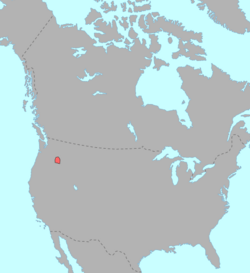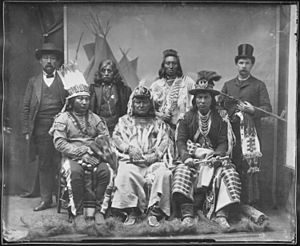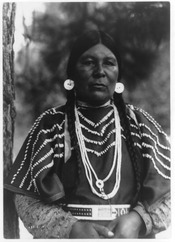Cayuse people facts for kids

The Cayuse Tribe land area
|
|
| Total population | |
|---|---|
| 2010: 304 alone and in combination | |
| Regions with significant populations | |
| Washington, Oregon | |
| Languages | |
| English, Cayuse (extinct) | |
| Religion | |
| Animism, Christianity | |
| Related ethnic groups | |
| Umatilla, Walla Walla, Nez Perce |
The Cayuse are a Native American tribe. They originally lived in what is now northeastern Oregon and southeastern Washington. Today, the Cayuse tribe shares a reservation and government. This reservation is in northeastern Oregon. They share it with the Umatilla and Walla Walla tribes. Together, they form the Confederated Tribes of the Umatilla Indian Reservation. The reservation is close to Pendleton, Oregon, near the Blue Mountains.
The Cayuse called themselves the Liksiyu in their own language. They lived next to the Nez Perce people and were very close to them. Like tribes on the Great Plains, the Cayuse were skilled horsemen. They valued bravery in battle. They even developed their own special horse breed, called the Cayuse pony. In 1855, the Cayuse gave up most of their traditional lands to the United States through a treaty. They then moved to the Umatilla Reservation.
Contents
History of the Cayuse People
The name Cayuse comes from a French word, "cailloux." This word means "stones" or "rocks." French Canadian fur trappers gave them this name. It might have been because they lived in a rocky area. Or it could have been a different way of saying their own name, Liksiyu. The Cayuse tribe was often connected with the nearby Nez Perce and Walla Walla tribes.
The Cayuse language was unique. It was a language isolate, meaning it was not related to other languages spoken nearby. In the 1700s, there were about 500 Cayuse people.
Life as a Nomadic Tribe
The Cayuse were a semi-nomadic tribe. This means they moved around for parts of the year. They had summer and winter villages. These villages were along rivers like the Snake, Umatilla, and Walla Walla. Their lands stretched from the Blue Mountains to the Deschutes River in Oregon.
The Cayuse were famous for their bravery and their horses. They bred their horses to be fast and strong. This special breed is now known as the Cayuse horse. Having horses allowed them to travel far. They could go as far east as the Great Plains. They also traveled south to California. They went to hunt, trade, fight, and sometimes capture people. Their horse herds grew quickly. By the early 1800s, a wealthy Cayuse family might own 2,000 or more horses. Horses helped them become powerful. They controlled important fishing and trading spots along the Columbia River. They often fought with other tribes like the Piute, Shoshone, and Bannock over land and hunting areas.
Arrival of Settlers and Conflict
When white settlers started moving into their lands, the Cayuse faced many problems. This happened after the Oregon Trail opened in 1842. Even settlers just passing through competed for game and water. Many more white people came during the California Gold Rush starting in 1848. Gold was also found in Eastern Oregon in 1862.
In 1838, a missionary named Marcus Whitman and his wife Narcissa started a mission. It was among the Cayuse at a place called Waiilatpu. This spot was near present-day Walla Walla. In 1847, a serious measles sickness spread. Many Cayuse people died from it. The Cayuse noticed that more of their people were dying than the white settlers. Some Cayuse believed the missionaries were poisoning them. Also, there were growing tensions due to cultural differences. Settlers were also moving onto Cayuse lands.
A group of Cayuse attacked the mission. They killed Marcus and Narcissa Whitman and eleven other people. They also took 54 European-American women and children as captives. The mission buildings were destroyed. This event led to a war with the United States, called the Cayuse War. Five Cayuse warriors later faced consequences for the attack.
The Cayuse made the captives work alongside their own people. The adults made clothes for the tribe. The captives were later released. This happened after the Hudson's Bay Company helped arrange a trade. The Cayuse received blankets, shirts, rifles, ammunition, tobacco, and flints. After the war, the Cayuse lost. They were forced to give their land to the U.S. government. They then shared a reservation with the Umatilla and Walla Walla tribes.
By 1851, many Cayuse had married into the Nez Perce tribe. They had also learned the Nez Perce language. In 1855, the Cayuse joined the Treaty of Walla Walla. This treaty formed the Umatilla Indian Reservation. Since then, they have officially lived on this reservation.
Cayuse Lifestyle
The Cayuse people lived in the Columbia Basin. They were nomadic, often moving daily. They used teepees for shelter. Teepees were easy to move, which was perfect for a nomadic lifestyle. The Cayuse were excellent horse riders. They used horses for hunting. They also rode their horses over the Rocky Mountains each year. This trip was to hunt buffalo for their families.
Cayuse men hunted game like deer and elk. They also fished for salmon. The women gathered berries and dug for roots. They also prepared animal skins to make shelters and clothing. Bravery was very important to the men. Brave warriors were highly respected. The strongest warriors often became chiefs.
Cayuse Language
The Cayuse language is a language isolate. This means it is not clearly related to any other known language family. Some scholars think it might be related to the Molala language. If so, they would form a small language family called Waiilaptuan. This family might then be part of a larger group called Penutian. However, this idea has not been fully proven. The Cayuse language has not been spoken since the 1930s.
Today, a dialect of the Nez Perce language is used by the Cayuse people. It is called Weyíiletpuu. The original Cayuse language has not been used since the 1940s. It is now considered extinct.
Cayuse Food
One of the main foods for the Cayuse was salmon from the Columbia River. They also ate trout and eels. For meat, they hunted elk, deer, rabbits, and birds. Women were very important for gathering food. They collected camas roots, bitter roots, wild celery, huckleberries, and choke cherries. They prepared these foods to eat fresh or to dry for later. They also gathered bark, leaves, flowers, and roots to make medicines.
Notable Cayuse Leaders
- Tawatoy (known as Young Chief): He was a respected leader and warrior. He was the uncle of the next Young Chief.
- Weatenatemany (also known as Young Chief, died 1859): He became the new Young Chief in 1853. He was Tawatoy's nephew. He led the group of Cayuse who wanted peace. He was killed in a fight with the Snake tribe.
- Five Crows (also known as Achekaia or Hezekiah): He was the brother of Tauitau. He led the group of Cayuse who were against the settlers. He was a main rival to Young Chief (Weatenatemany) for the role of Head Chief.
See also
 In Spanish: Cayuse para niños
In Spanish: Cayuse para niños




